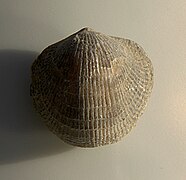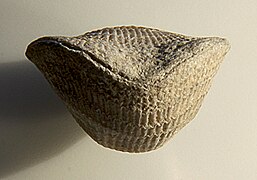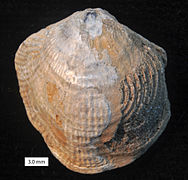Atrypa
| Atrypa | |
|---|---|

| |
| Atrypa reticularis, 26mm, Eifel, Germany | |
| Scientific classification | |
| Kingdom: | |
| Phylum: | |
| Class: | |
| Order: | |
| Suborder: | |
| Family: | |
| Genus: | Atrypa Dalman, 1828
|
| Species | |
| Synonyms | |
|
Cleiothyris Phillips, 1841, Mikrothyris | |
Atrypa is a genus of brachiopod with shells round to short egg-shaped, covered with many fine radial ridges (or costae), that split further out and growthlines perpendicular to the costae and 2-3 times wider spaced. The pedunculate valve is a little convex, but tends to level out or even become slightly concave toward the anterior margin (that is: opposite hinge and pedicle). The brachial valve is highly convex. There is no interarea (that is a flat area bordering the hinge line approximately perpendicular with the rest of the valve) in either valve. Atrypa was a cosmopolitan and occurred from the late Lower Silurian (Telychian) to the early Upper Devonian (Frasnian).[4] Other sources expand the range from the Late Ordovician to Carboniferous, approximately from 449 to 336 Ma.[3] A proposed new species, A. harrisi, was found in the trilobite-rich Floresta Formation in Boyacá, Colombia.[5]
Reassigned species
As Atrypa was erected early on, many species have been reassigned since.[4]
Organic content of Atrypa fossils
In some fossil material, organic compounds may be preserved. Only the more stable amino acids tend to be preserved in very old fossils. In specimens of Atrypa reticularis from the Wenlock Shales (Lower Silurian), alanine, glycine, glutamic acid, leucine, isoleucine, proline, valine, and aspartic acid have been found.[4]
Gallery
-
Atrypa devoniana, pedicle valve
-
Atrypa devoniana, brachial valve
-
Atrypa devoniana, anterior view
-
Atrypa devoniana, posterior view
-
Atrypa devoniana, lateral view
-
Atrypa sp.; Couvinian (Middle Devonian); El Pical, Leon, Spain. Eroded to show spiralia on the right.
References
- ^ Paleobiodiversity in Baltoscandia. "Atrypa (Atrypa) reticularis". fossiilid.info. Retrieved 2012-03-22.
- ^ M.A. Stainbrook (1945). Brachiopoda of the Independence Shale of Iowa. Geological Society of America Memoirs. Vol. 14. ISBN 0813710146.
- ^ a b c d e f Atrypa at Fossilworks.org
- ^ a b c Moore, R.C. (1965). Brachiopoda. Treatise on Invertebrate Paleontology. Vol. Part H., Volume 1 and 2. Boulder, Colorado/Lawrence, Kansas: Geological Society of America/University of Kansas Press. ISBN 0-8137-3015-5.
- ^ Floresta Series Fauna at Fossilworks.org
- Spiriferida
- Prehistoric brachiopod genera
- Silurian brachiopods
- Devonian brachiopods
- Paleozoic animals of Africa
- Paleozoic animals of Asia
- Paleozoic brachiopods of Oceania
- Paleozoic animals of Europe
- Paleozoic animals of North America
- Paleozoic brachiopods of South America
- Devonian Colombia
- Fossils of Colombia
- Silurian first appearances
- Frasnian extinctions
- Fossils of Georgia (U.S. state)
- Jeffersonville Limestone
- Paleontology in New Hampshire
- Paleozoic life of Ontario
- Paleozoic life of Alberta
- Paleozoic life of British Columbia
- Floresta Formation
- Paleozoic life of Manitoba
- Paleozoic life of New Brunswick
- Paleozoic life of the Northwest Territories
- Paleozoic life of Nova Scotia
- Paleozoic life of Nunavut
- Paleozoic life of Quebec
- Paleozoic life of Yukon
- Fossil taxa described in 1828
- Brachiopod stubs






